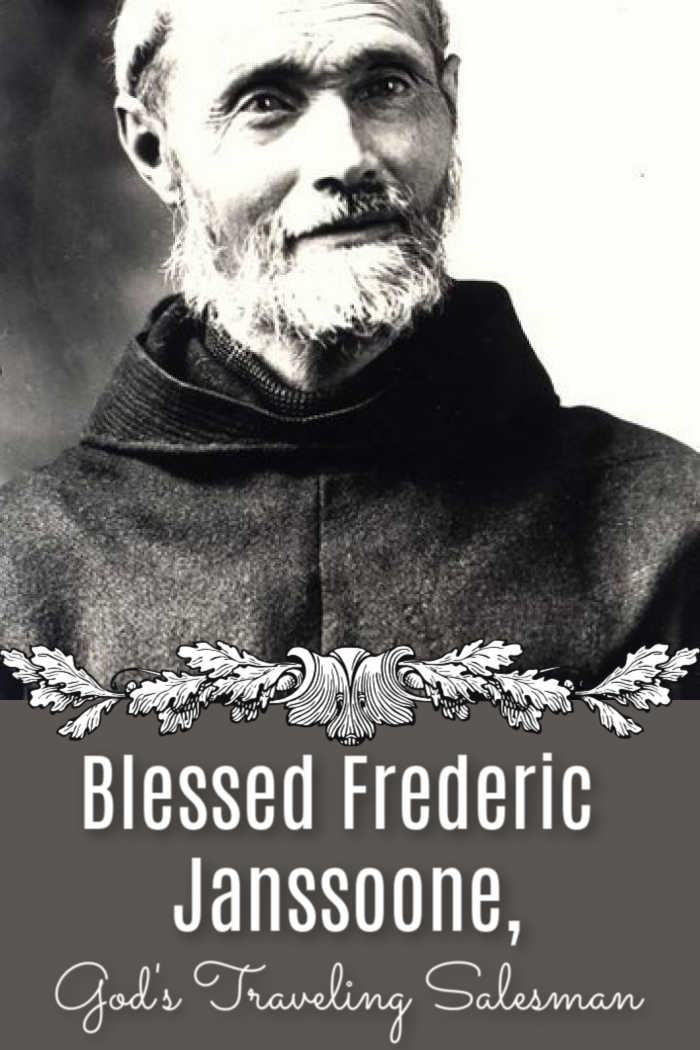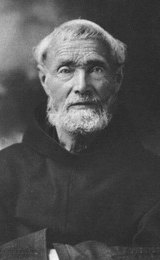Today is the feast day of Blessed Frédéric Janssoone, a Franciscan priest who was born in France, served in the Holy Land, and died in Canada. He initiated a spiritual renewal in Canada based on meditation on the suffering and passion of Christ.

Blessed Frédéric Janssoone‘s Childhood
Frédéric was born into a devout farming family in northern France in 1838. He was the youngest of thirteen children. His parents were educated and hard working and instilled in Frederic the values of self-control, integrity, courtesy, faith and charity. They frequently prayed the rosary together as a family.
However, his father died of stomach cancer when Frédéric was only 9. He felt drawn to the priesthood and was a diligent, exemplary student. However, a few years later, Frédéric had to leave school to support his mother. He worked as an errand boy and then was very successful as a traveling salesman. His business skills would serve him well throughout his life.
After his mother died in 1861, Frédéric returned to school to complete his studies. He then joined the Franciscan Order of Friars Minor. He was ordained a priest in 1870. During the Franco-Prussian War, he served as a military chaplain. After, he served as assistant novice director, librarian, and community superior. He also completed a course in practical homiletics, another skill at which he excelled.
The greatest desire and prayer of Blessed Frédéric Janssoone was to help others come closer to God. His ministry as a Franciscan help him to do that, and took him to many places, from Europe, to the Holy Land and then to North America, where he died. ~ Catholic News Agency
Travels in the Holy Land

In 1876, he traveled to the Holy Land and spent the next twelve years there. These years were to become the defining moments of Father Frédéric’s life. The Franciscans had an international province of 350 members in Palestine, known as the Custodia of the Holy Land.
Father Janssoone spent two years in Cairo, Egypt as a chaplain, and then returned to Jerusalem. He spent the next decade there as the custodial curate. This was an administrative position that involved looking after the construction and maintenance of Catholic churches and convents, providing spiritual services to the French communities there, and being a French diplomat.
During this time, he built the church of St Catherine in Bethlehem and the church of the Holy Savior in Jerusalem. Doing so required great diplomacy and tact, as the Holy Land face religious and political instability then as now. To prevent the conflicts between various religious groups about the uses of churches in the Holy Land, Father Frederic wrote down regulations and customs that had been only oral before. These regulations are still in place today.
In 1878, Father Frédéric restored the Franciscan practice of praying along the Via Dolorosa on Good Friday. This had been a tradition of the Franciscans in the Holy Land since the 14th century. It was the origin of the devotion of the Way of the Cross. Father Frederic was so well respected that the Ottoman political authority gave him permission to officially preach in public on Good Friday.
Father Janssoone also promoted pilgrimages to the Holy Land. His own travels throughout the Holy Land had given him a deep knowledge of its history. He himself welcomed and guided many pilgrims through the places he’d come to know and love. It was through these pilgrimages that he met a Canadian priest who invited him to Canada.
In 1881, Father Frédéric arrived in Canada on a fundraising tour. He spent that winter preaching throughout Quebec. He inspired the archbishop of Quebec to establish the collection for the Holy Land which is still taken in churches across Canada on Good Friday.
In May, he returned to Jerusalem exhausted and tired. However, the French Canadians, who saw Father Frédéric as a successor to their first missionaries, the Franciscan Recollets, wanted him back.
He could influence people by using his ability to communicate and persuade, a talent which makes good salesmen and great orators. He possessed this gift to a degree that made him the equal of the most famous preachers of his order. ~ Dictionary of Canadian Biography
Blessed Frédéric Janssoone’s Work in Canada
In 1888, Father Janssoone returned to settle permanently in Trois-Rivières (a town well-known to the North American martyrs). He built a small Holy Land commissariat there, the first Franciscan building in Quebec since the Recollects had left. From there, Father Frederic went out as a missionary to every diocese in Quebec and even traveled to New England.
One of his first tasks in Quebec was to develop a pilgrimage to Notre-Dame-du-Cap, a Marian shrine several miles from Trois-Rivières. By 1902, when the Oblates of Mary Immaculate took over the shrine, crowds of 30,000-40,000 pilgrims were gathering there every year. Just as he had promoted pilgrimages to the shrines of the Holy Land, now he promoted pilgrimages to local Canadian shrines.
Blessed Frédéric Janssoone’s “first and foremost heritage is the way he developed strong bonds between the Catholics of Canada and the spiritual roots of their religion – namely the Middle East places where Jesus, the apostles and the first witnesses of Christ have lived.” ~ Father Roland Bonenfant, postulator for Bl. Frederic’s cause for canonization
Father Frédéric then became a traveling salesman for God. Dressed simply, sleeping on the ground and fasting frequently, he traveled throughout Quebec raising money for various diocesan or Franciscan works. He preached in the churches, sold his books, and helped the sick and and afflicted. Many compared him to St. Francis of Assissi and called him “the Holy Father.”
A true Franciscan, Father Frédéric practiced the strictest poverty, not only eliminating the unnecessary, but even allowing necessary things sparingly. As a fundraiser, large sums of money passed through his hands; but his clothes, his food, his furnishings, all reflected great detachment. ~ Dom Antoine Marie OSB
During this time, Father Janssoone was a prolific writer. He founded two magazines, the Annales du T. S. Rosaire (Cap-de-la-Madeleine) in 1892 and the Revue eucharistique, mariale et antonienne (Québec) in 1901. He wrote many of the articles for these magazines himself.
He also wrote newspaper and magazine articles, pamphlets, and books on the lives of Jesus, Mary, St. Joseph, St. Anne, St. Francis of Assisi, St. Anthony of Padua, and the Recollet Brother Didace Pelletier.
The sole objective of all his efforts during the 28 years he spent in the country was to win for God and for Christ the Canadians whom he loved so dearly, and to enhance their spiritual lives as much as possible. ~ Constantin-M. Baillargeon
Blessed Frédéric Janssoone’s Death and Cause for Sainthood
In June 1916, Father Frédéric was exhausted and suffering from stomach cancer. He spent nearly two months in bed, suffering physically and mentally, before passing away on August 4. His body was taken to Trois-Riveries, where it remains.
All in all, the role Father Frédéric played in Quebec was analogous to the one played in France by his compatriots Jean-Baptiste-Marie Vianney and Thérèse Martin: that of a living witness to the reality and holiness of God. ~ Dictionary of Canadian Biography
Just eleven years after his death, the cause for his canonization was opened. He was beatified in 1988 by Pope Saint John Paul II. His feast is celebrated on August 5.
Blessed Frédéric Janssoone is one of twelve holy Canadians beautified by the Catholic Church. Perhaps he will soon be Canada’s newest Catholic saint.

No Responses Yet